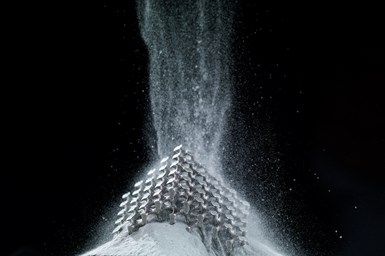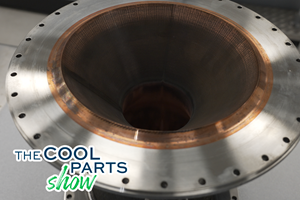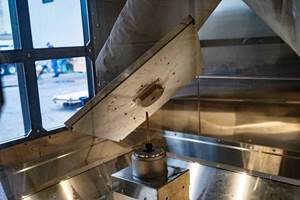ArcelorMittal Enters Additive Manufacturing Industry With Steel Powder
The company is building an industrial-scale atomizer in Spain to produce high-quality steel powders for multiple additive manufacturing technologies.
Share
Read Next
ArcelorMittal is entering the additive manufacturing (AM) market as a steel powder supplier with the building of an industrial-scale inert gas atomizer in Aviles, Spain. That facility will produce steel powders for AM technologies such as laser powder bed fusion (LPBF), binder jetting and directed energy deposition (DED).
The atomizer, which will start production in January 2024, will have a large batch-size production capability, from 200 kg to 3 tons, and an initial annual capacity of 1,000 tons. The company says this will enable it to supply significant volumes of steel powders with consistent quality, reliability and traceability, meeting the high standards and specifications of the AM industry.
In line with ArcelorMittal’s commitment to sustainability and decarbonization, the company is committed to advancing the sustainability of AM. The atomizer will produce powders from scrap steel, using renewable electricity, atomizing with industrial gases produced by renewable energy, and using recycled and recyclable packaging solutions.
A new business unit, ArcelorMittal Powders, has been established to commercialize the output of the atomizer. The steel powders will be offered in size ranges suitable for all existing powder-based metal AM technologies in manufacturing industries such as aerospace, defense, automotive, medical and energy. They can also be used in the latest technological developments such as the brake disc coatings being developed to help Automotive OEMs and Tier Ones comply with the EU7 regulation on particle emissions. A layer of powder deposited on the brake disc provides wear and corrosion resistance which significantly reduces the particulate emissions of braking.
“By producing and supplying steel powders for additive manufacturing, we are expanding our portfolio of advanced materials and solutions for the future of manufacturing,” says Gregory Ludkovsky, ArcelorMittal CEO of Global Research and Development. “We believe that steel has great potential to become the material of choice for additive manufacturing, thanks to its versatility, performance and sustainability.”
With the additive manufacturing industry expected to continue to grow in double digits over the next 10 years, the launch of ArcelorMittal Powders reflects the company’s vision to be at the forefront of innovation and sustainability in the steel industry. “While the production of steel powders is a new venture for ArcelorMittal, we are confident that our metallurgical expertise and solutions-based approach will provide our customers with the support they need to improve the quality and reliability of their additive manufacturing projects,” Ludkovsky adds.
Additive manufacturing is an area the company has been investing in and building its capabilities for several years. “We are now ready to scale up our production and offer our customers and partners a reliable and competitive source of high-quality steel powders,” says Colin Hautz, CEO of ArcelorMittal Powders. “From our facility in Spain, we will offer a range of steel powders tailored to our customers’ needs. A technology as innovative and disruptive as additive manufacturing not only allows us to think about changes in the design and manufacturing process of many parts and components we use today but also exploit one of the inherently sustainable characteristics of steel — its recyclability.”
Marketed under the AdamIQ brand name, ArcelorMittal’s product portfolio will include stainless steels (316L, 430L, 17-4PH), tool steels (H11, H13, M300) and low alloy steels (a dual-phase alloy; 4140 equivalent). Drawing on its metallurgical expertise, ArcelorMittal’s research and development team intends to add further steel powder products for customers to test in 2024.
ArcelorMittal believes that AM can create new opportunities for manufacturing industries, by enabling the production of complex, customized parts with enhanced properties while simultaneously reducing material waste. The company is now looking to scale up its participation in the AM market and, mirroring its successful approach with its S-in motion program in the automotive sector, intends to scale its steel powders offering in collaboration with customers and industrial partners, through co-design and co-engineering projects.
ArcelorMittal has been producing steel powders in a pilot atomizer at its AM lab in Aviles since 2018. With its dedicated research and development facilities and over 50 full-time researchers, ArcelorMittal has developed a detailed understanding of the interactions between steel alloy design, atomization parameters, AM process parameters and the final properties of the printed parts.
Through its AM and Digital Research Center, ArcelorMittal has already collaborated with customers and partners on various projects, such as the development of a generative design steel motorbike chassis, the optimization of AM productivity through software algorithms and, with a JV partner, the production of over 10 tons of 1,600 different spare parts per year, for its own steel plants.
- Learn more about binder jetting in our AM 101 section. Binder jetting requires no support structures, is accurate and repeatable, and is said to eliminate dimensional distortion problems common in some high-heat 3D technologies. Here is a look at how binder jetting works and its benefits for additive manufacturing.
- What is powder bed fusion 3D printing? Whether in metal or polymer, with a laser or an electron beam, powder bed fusion (PBF) is one of the most widely used 3D printing techniques.
Related Content
Video: AM for Repair of Large Shafts
Wind power shafts that might once have been scrapped are now returned to service. See the robotic directed energy deposition (DED) and shaft preheating system developed by Ikergune, Izadi and Talens.
Read More3D Printed NASA Thrust Chamber Assembly Combines Two Metal Processes: The Cool Parts Show #71
Laser powder bed fusion and directed energy deposition combine for an integrated multimetal rocket propulsion system that will save cost and time for NASA. The Cool Parts Show visits NASA’s Marshall Space Flight Center.
Read MoreBig Metal Additive: The Difference Between a Shape and a Part Is Quality
Preparing to scale directed energy deposition to ongoing full production is not a technological challenge: DED is ready. But it is an organizational challenge, says the company founder. Here is what it means to implement a quality system.
Read MoreThe Cold Spray Solution to the Casting, Forging Supply Chains
Startup HAMR Industries performs additive manufacturing work at Neighborhood 91 that provides an alternative to traditional casting and forging. Success so far has led to redefining the limits of its additive equipment.
Read MoreRead Next
Profilometry-Based Indentation Plastometry (PIP) as an Alternative to Standard Tensile Testing
UK-based Plastometrex offers a benchtop testing device utilizing PIP to quickly and easily analyze the yield strength, tensile strength and uniform elongation of samples and even printed parts. The solution is particularly useful for additive manufacturing.
Read MoreBike Manufacturer Uses Additive Manufacturing to Create Lighter, More Complex, Customized Parts
Titanium bike frame manufacturer Hanglun Technology mixes precision casting with 3D printing to create bikes that offer increased speed and reduced turbulence during long-distance rides, offering a smoother, faster and more efficient cycling experience.
Read MoreCrushable Lattices: The Lightweight Structures That Will Protect an Interplanetary Payload
NASA uses laser powder bed fusion plus chemical etching to create the lattice forms engineered to keep Mars rocks safe during a crash landing on Earth.
Read More





















